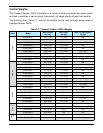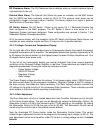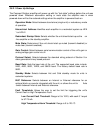
Operations Manual, HPA2, Compact Outdoor SSPA 205486 REV F 27
3.4 Alarms (J4)
A variety of alarm signals are present at the M&C connector, J4. Both Form-C relays and
open collector outputs are available. An amplifier summary alarm is available in both Form C
relay and open collector output. Detailed internal faults are available in open collector form
and include: voltage, current, and over-temperature.
3.4.1 Summary Alarm (J4) Form C Contacts
The Summary Alarm is accessible in both Form C relay and open collector format. The form
C relay is “energized” under normal operating conditions and “deenergized” when a fault
condition exists.
3.4.2 Auxiliary Alarm (J4) Form C Contacts
The Auxiliary Alarm relay is an end user alarm that can be used to signal an alarm condition
that is dependent on the state of the Auxiliary Input (J4-Pin P).
The Auxiliary Input is a contact closure to ground. When this input is pulled to ground the
Auxiliary Alarm relay is energized (Normal State). When the Auxiliary Input is open circuited
the Auxiliary Alarm relay is de-energized (Alarm State).
One example usage of the Auxiliary Alarm is that it could be used to signal one of the detail
alarms (voltage, current, or temperature) by connecting the appropriate open collector alarm
output to the Auxiliary Input. This programs the Auxiliary Alarm relay to be either a voltage,
current, or temperatue Form C relay alarm.
3.4.3 Open Collector Alarm Outputs (J4)
The open collector alarm outputs will require external pull-up resistors (unless connected to
the Auxiliary Input). They are capable of sinking up to 20mA current at 30 VDC. The open
collector outputs are pulled to ground under normal operating conditions and switch to high
impedance state during an alarm condition.
Auxiliary Alarm: follows state of Auxiliary Input as described above
Voltage Alarm: high when amplifier’s internal regulator voltage falls below its
acceptable level
Current Alarm: high when the amplifier’s operating current falls below its acceptable
level
Temperature Alarm: high when the amplifier’s baseplate temperature rises above its
acceptable threshold of 90°C. A 5°C hysteresis window exists in the temperature
alarm.
Spare Alarm: high when the phase locked local oscillator’s lock alarm is triggered


















